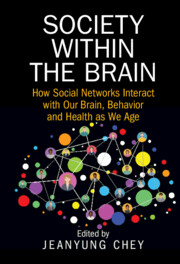Book contents
- Society within the Brain
- Society within the Brain
- Copyright page
- Dedication
- Contents
- Figures
- Tables
- Contributors
- Preface
- Introduction
- Part I Approaches to Society within the Brain
- Part II Society Interacting with Brain, Cognition, and Health in Late Life
- Part III An Individual’s Cognitive Aging with Others: Key Findings, Issues, and Implications
- Chapter 9 Social Relationships and Cognitive Function in Older Adults
- Chapter 10 Social Network and the Brain
- Chapter 11 Origins of Individual Differences in Social Behavior and the Social Brain
- Chapter 12 Preventing Dementia with Social Connection
- Index
- References
Chapter 10 - Social Network and the Brain
from Part III - An Individual’s Cognitive Aging with Others: Key Findings, Issues, and Implications
Published online by Cambridge University Press: 28 September 2023
- Society within the Brain
- Society within the Brain
- Copyright page
- Dedication
- Contents
- Figures
- Tables
- Contributors
- Preface
- Introduction
- Part I Approaches to Society within the Brain
- Part II Society Interacting with Brain, Cognition, and Health in Late Life
- Part III An Individual’s Cognitive Aging with Others: Key Findings, Issues, and Implications
- Chapter 9 Social Relationships and Cognitive Function in Older Adults
- Chapter 10 Social Network and the Brain
- Chapter 11 Origins of Individual Differences in Social Behavior and the Social Brain
- Chapter 12 Preventing Dementia with Social Connection
- Index
- References
Summary
The social brain hypothesis originally developed by evolutionary psychologists has focused on the neural foundation of one of the most unique human characteristics: complex social interactions involving social networks. Although there is evidence to suggest that the capacity of the social brain contributes significantly to the size and position of one’s social network, it is also possible that social networking influences the structure and function of the individual’s brain. By using the unique features of the Korean Social Life, Health, and Aging Project (KSHAP), a dataset equipped with both neuroimaging data and comprehensive tracking of the social networks of the residents of two villages, this chapter explores the possible mechanisms through which brain and social networks interact with each other to form and change the social brain. It examines this relationship with studies utilizing mostly volumetry and resting-state activation of the brain. The studies show how social brain volume and connectivity are related to not only social network size but also to a variety of social network indices. By employing these indices, studies have been able to link the complex social world to human beings’ social brain in recent years. Furthermore, the chapter discusses causality issues in the relationship between the social brain and social networks.
Keywords
- Type
- Chapter
- Information
- Society within the BrainHow Social Networks Interact with Our Brain, Behavior and Health as We Age, pp. 217 - 230Publisher: Cambridge University PressPrint publication year: 2023



